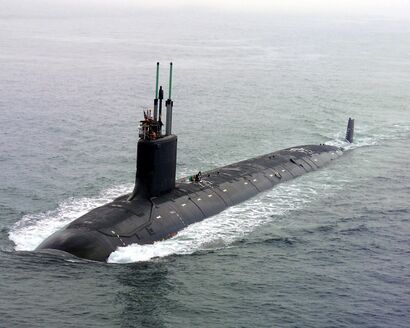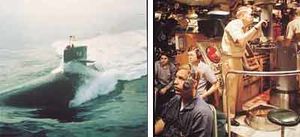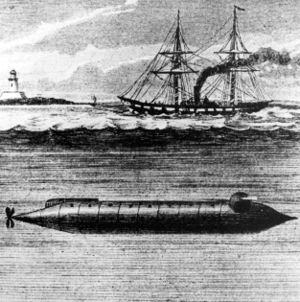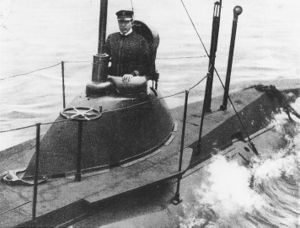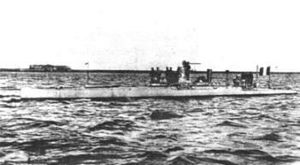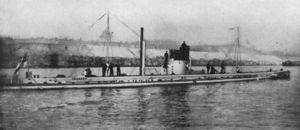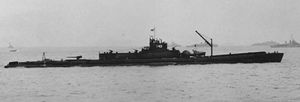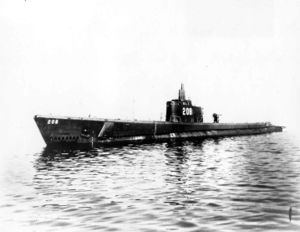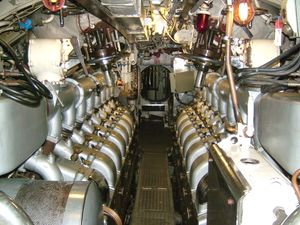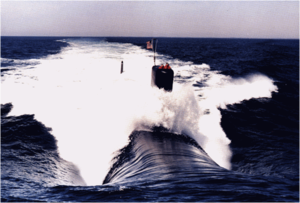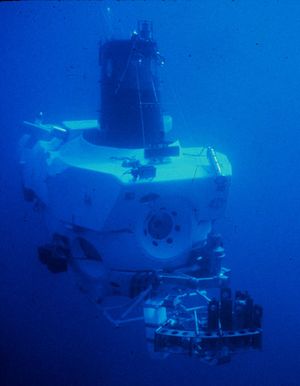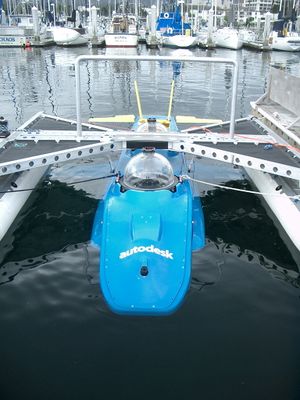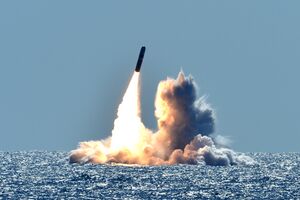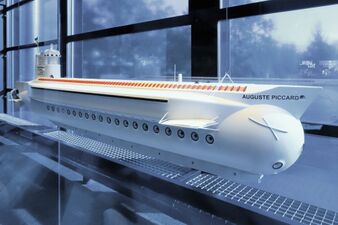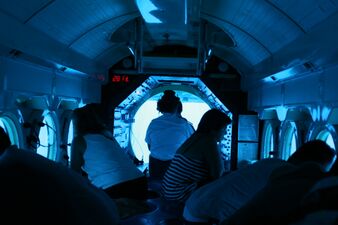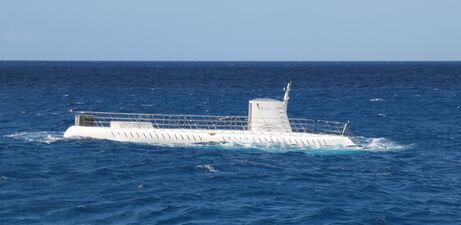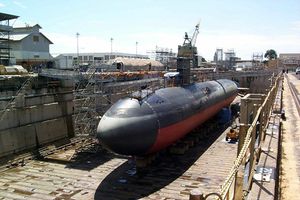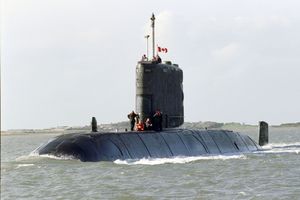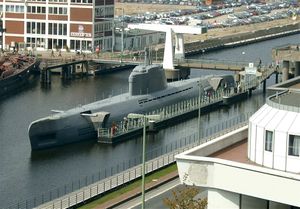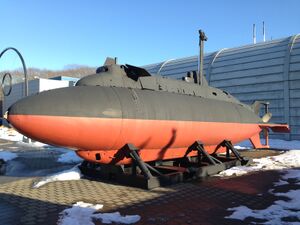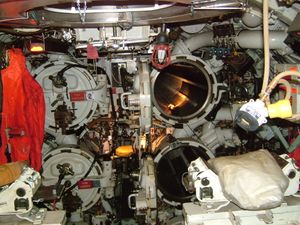غواصة
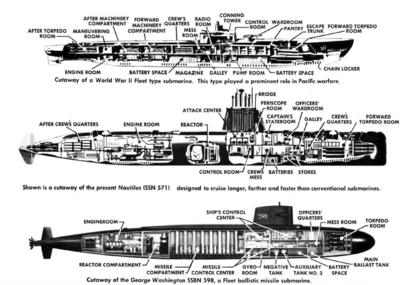
- World War II fleet submarine, commissioned 1941–1945
- The first nuclear-powered submarine يوإسإس Nautilus (SSN-571), commissioned 1954:
- The first ballistic missile submarine يوإسإس George Washington (SSBN-598), commissioned 1959
الغواصات سفينة متخصصة يمكنها أن تغوص تحت سطح الماء و كذلك أن تطفو و بإمكانها التنقل تحت سطح الماء تم إستعمالها لأول مرة على نطاق واسع اثناء الحرب العالمية الأولى لأغراض عسكرية، و تستخدم بشكل واسع في سلاح البحرية للدول العظمى كروسيا و الولايات المتحدة و فرنسا و المملكة المتحدة.
Although experimental submarines had been built earlier, submarine design took off during the 19th century, and they were adopted by several navies. They were first widely used during World War I (1914–1918), and are now used in many navies, large and small. Military uses include attacking enemy surface ships (merchant and military) or other submarines, and for aircraft carrier protection, blockade running, nuclear deterrence, reconnaissance, conventional land attack (for example, using a cruise missile), and covert insertion of special forces. Civilian uses include marine science, salvage, exploration, and facility inspection and maintenance. Submarines can also be modified for specialized functions such as search-and-rescue missions and undersea cable repair. They are also used in tourism and undersea archaeology. Modern deep-diving submarines derive from the bathyscaphe, which evolved from the diving bell.
Most large submarines consist of a cylindrical body with hemispherical (or conical) ends and a vertical structure, usually located amidships, that houses communications and sensing devices as well as periscopes. In modern submarines, this structure is the "sail" in American usage and "fin" in European usage. A "conning tower" was a feature of earlier designs: a separate pressure hull above the main body of the boat that allowed the use of shorter periscopes. There is a propeller (or pump jet) at the rear, and various hydrodynamic control fins. Smaller, deep-diving, and specialty submarines may deviate significantly from this traditional design. Submarines dive and resurface by means of diving planes and changing the amount of water and air in ballast tanks to affect their buoyancy.
Submarines encompass a wide range of types and capabilities. They include small autonomous examples using A-Navigation and one- or two-person subs that operate for a few hours, to vessels that can remain submerged for six months—such as the Russian Typhoon طراز, the biggest submarines ever built. Submarines can work at greater depths than are survivable or practical for human divers.[1]
الغواصات الغير حربية تستعمل عادة لأغراض البحث العلمي . تم لاحقا استعمال الغواصات لتحميل الأسلحة النووية . هناك غواصات تستعمل لأغراض سياحية وحسب إحصاءات 1996 كان هناك أكثر من 50 غواصة خاصة تستعمل لأغراض سياحية بحتة . مؤخرا تم تصنيع جيل جديد من الغواصات ذات التحكم الآلي البعيد والتي لا تحتاج إلى بحارين لقيادتها ويستعمل هذا النوع المتطور من الغواصات للبحث في المياه العميقة جدا للبحث عن النفط او عندما يكون العمق مصدر خطر على سلامة البحارة وقد تم استعمال الغواص الآلي في العثور على حطام السفينة المشهورة تيتانيك.
نظرة عامة
سفينة تسير تحت الماء. تصمَّم معظم الغواصات للاستخدام أثناء الحرب، لمهاجمة غواصات العدو وسفنه البحرية، ولضرب أهداف داخل الدول المعادية بالصواريخ. ويتراوح طول هذه السفن ما بين حوالي 60م وأكثر من 150م. أما جسمها المستدير فيصل نصف قطره إلى 9 أمتار. وتسع تلك السفن بداخلها أكثر من 100 من أعضاء الطاقم للمأوى والعمل.
وتُستخدم بعض الغواصات لأغراض البحث العلمي، حيث تجوب قيعان المحيطات لجمع المعلومات العلمية. ولكن هذه الغواصات أصغر حجماً من الغواصات العسكرية ولا تحمل سوى بضعة أشخاص.
وعادة ما تهاجم الغواصة أهدافها أثناء الحرب من تحت سطح الماء. ولكي تؤدي الغواصة دورها بفاعلية لابد من أن تبقى تحت الماء. غير أن الغواصات البدائية لم تكن تستطيع البقاء تحت الماء لفترات طويلة، ولذلك كانت تضطر إلى الخروج إلى السطح كل بضع ساعات للتزود بالهواء اللازم لمحركاتها وطواقمها، مما جعلها عرضة لهجمات طائرات وسفن العدو.
وفي يومنا هذا، تستطيع الغواصات النووية البقاء تحت الماء لعدة شهور دون الخروج إلى السطح، ذلك لأن المحركات النووية لا تحتاج في عملها إلى أكسجين. كما أن الغواصات الحديثة تستطيع أن تنتج كل الهواء الذي تحتاجه أطقمها. إضافة إلى ذلك، فإن الغواصات الحديثة تكاد تكون صعبة الاكتشاف عند وجودها تحت سطح الماء، لأن محركاتها ومراوحها الدافعة مصممة للعمل بأقل قدر من الضوضاء.
وجسم الغواصة الطويل الأسطواني الشكل يساعدها على سرعة الحركة تحت سطح الماء، كما أن بدنيها (جسميها) يحميانها من ضغط الماء. فالبدن الداخلي، الذي يُسمى بدن الضغط، يقي الغواصة من قوة ضغط الماء العالي في الأعماق البعيدة، وهو مبني من الفولاذ القوي السميك. أما البدن الخارجي فيغلف البدن الداخلي، ويحتوي على فتحات تسمح بدخول الماء لإعطاء الغواصة الثقل الموازن للغوص.
ويطل من منتصف ظهر الغواصة بحوالي 6 أمتار بناء طويل رفيع يسمى الشِّراع، يحوي بداخله البريسكوبات (مناظير الأفق) والرادار وهوائيات الراديو. وتستخدم قمة الشِّراع أيضًا غرفة قيادة يوجه منه الربان الغواصة على السطح. وتبرز من جانبي الشراع والمؤخرة زعانف فولاذية تسمى جنيحات الغوص، تعمل على توجيه الغواصة نحو الأعماق المختلفة. وتُدفع الغواصة إلى الأمام بوساطة مروحة دفع موجودة بالمؤخرة، بينما توجه بوساطة دفتي توجيه مركَّبتين فوق مروحة الدفع وتحتها. [2]
التاريخ
*أنظر مخترع الغواصة جون هولاند
الغواصات هى بواخر قادره على الابحار على سطح او في عمق المياه. و أول غواصه صممت في عام 1620 على يد الألماني كورنليوس فان دربل Cornelius van Drebbel. نحن لا نعرف الكثير عن أول غواصة، ولكن الكتب و المراجع في هذا الوقت تقول أن أول غواصة كانت عبارة عن مركب مغطاة بحاجز مياه من الجلد وكانت بحاجه لاثنى عشر رجل لحملها إلى الماء وكانت تغطس أربعه امتار تحت الماء وتقطع مسافه أربعه كيلومترات قبل أن تحتاج إلى السطح. وقد كان بها كوة لادخال النور والرؤية تحت الماء.
ولكن الوضع اختلف كثيرا عن ايام دربل. فالغواصات الآن تصل إلى 200 متر في طولها وبعضها يحمل 150 بحار ويبقى لعدة شهور في قاع المحيطات. ففى عام 1770 قام المهندس البريطانى داڤيد بوشنل David Bushnell بتصميم أول غواصة لاستخدام حربى وكانت تسمى Turtle.
هذه الغواصة كان بها كميه كافيه من الهواء لتحمل شخص واحد لمده نصف ساعه تحت الماء و كان بها اداه حاده لثقب سفن العدو واغراقها. و قد تطورت هذه الغواصه لتزرع القنابل في سفن العدو.
ولكن مع بداية القرن الثامن عشر, اصبحت السفت الحربيه تصنع من لوحات الحديد مما نتج عنه فشل هذه الغواصه في هذه الفتره. و لكن مع بدايه الحرب الأهليه بالقاره الأمريكيه في بدايه ستينات القرن الثامن عشر, اثبتت الغواصات انها من اقوى الأسلحه الحربيه. فهى جيش كامل مخفى تحت سطح البحر.. و مع مرور السنوات, تطورت الغواصه و ظهرت قوتها في الحرب العالمية الأولى والثانية وتعددت استخدامتها من بعد ذلك.
أول الغواصات الحربية
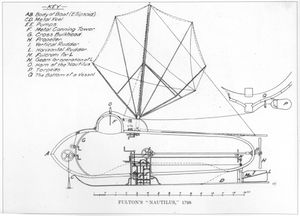
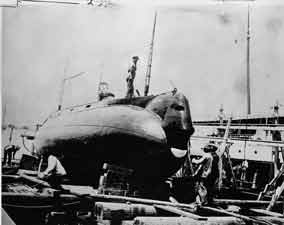
كانت أول غواصة صالحة للعمل مركب تجديف خشبيًا مغطى بجلود لا ينفذ منها الماء. وقد تمكن صانع هذه الغواصة، وهو عالم هولندي يدعى كورنيلياس فان دريبيل، من عرض اكتشافه لأول مرة في إنجلترا حوالي عام 1620م. وفي القرن التالي بنى المصممون عددًا من السفن التحتمائية، غير أن تلك السفن لم تعد بفائدة تذكر حتى اندلاع الثورة الأمريكية (1775 - 1783م). وفي تلك الحرب، قام الطالب ديفيد بوشنل بتصميم السلحفاة، وهي غواصة لرجل واحد، تسير بمروحة دفع تدار برفَّاص يدوي. وفي عام 1776م أخفقت السلحفاة في محاولة إغراق سفينة حربية بريطانية في خليج نيويورك. وكانت هذه المهمة أول هجوم معروف قامت به غواصة.
وفي عام 1800م، بنى المكتشف الأمريكي روبرت فولتن الغواصة نوتيلوس، وهي غواصة مغطاة بالنحاس، طولها 6,4م. وقد حاول فولتن بيع غواصته نوتيلوس لفرنسا ومن ثم لبريطانيا، غير أن كلتا الدولتين لم تبديا اهتمامًا بالغواصة برغم نجاحها في إغراق عدة سفن في عروضها التجريبية.
الغواصات في الحرب الأهلية الأمريكية
وفي الحرب الأهلية الأمريكية (1861 - 1865م)، أصبحت الغواصة الكونفدرالية هنلي أول سفينة تحتمائية تغرق سفينة أثناء الحرب. وكانت هنلي تحمل شحنة متفجرة ملحقة بصارية طويلة على مقدَمها. وفي عام 1864م، تمكنت هنلي من قصف سفينة الاتحاد هوساتونيك في خليج تشارلستون قبالة شاطىء كارولينا الجنوبية. ومع أن هنلي أغرقت هوساتونيك، إلا أنها تبعت ضحيتها إلى القاع.
غواصات بالقوى الميكانيكية (أواخر القرن 19)
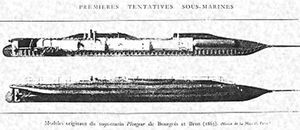
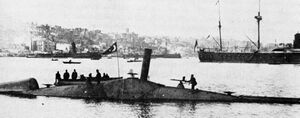
وفي عام 1898م دفع المكتشف الأمريكي جون هولاند غواصة طولها 16م إلى البحر، وكانت تعمل بمحرك جازولين وبطاريات كهربائية، وتسير تحت الماء بسرعة 6 عُقَد. وقد اشترت البحرية الأمريكية هذه الغواصة عام 1900م لتكون غواصتها الأولى تحت اسم يو إس إس هولاند. كما قام سايمون ليك، وهو مكتشف أمريكي آخر، بتصميم عدد من الغواصات، غير أن أهم إنجاز له هو اكتشاف بريسكوب الغواصة في عام 1902م. وقد استخدم بريسكوب ليك عدسات مكبرة ساعدت الغواصة على رؤية الأهداف البعيدة. وبنى ليك أيضًا غواصات ذات عجلات لمساعدتها على السير بيسر في عمق المحيط. وفي عام 1908م، تمكنت بريطانيا من إنزال أول غواصة تعمل بالديزل في عرض البحر . وكانت محركات تلك الغواصة أقوى عزمًا، وأقل تكلفة في العمل، كما أنها كانت تنتج أبخرة أقل خطورة من تلك التي تنتجها أبخرة محركات البترول. وقد استخدمت كل الغواصات محركات الديزل حتى خمسينيات القرن العشرين.
نهاية القرن 19 حتى الحرب العالمية الأولى
الغواصات خلال الحرب العالمية الأولى
الغواصات خلال الحرب العالمية الثانية
ألمانيا
برهنت ألمانيا خلال الحرب العالمية الأولى (1914 - 1918م) على فاعلية الغواصة بوصفها سفينة حربية رهيبة. ففي عام 1914م، أغرقت الغواصة الألمانية ثلاثة طرادات بريطانية خلال ساعة واحدة فقط، وحاصرت الغواصات الألمانية التي أُطلق عليها القوارب التحت بحرية أو القوارب يو - بوت إنجلترا وأحدثت خسائر فادحة بالسفن التجارية وسفن نقل الركاب، وهكذا أصبحت القوارب يو - بوت تُشكل رُعبًا في البحار من خلال شنها لحرب غير محدودة على سفن الحلفاء .
وفي مايو 1915م، ضربت غواصة ألمانية السفينة البريطانية لوسيتانيا بالطوربيدات وأغرقتها، مما أسفر عن مصرع 1,200 راكب تقريبًا في هذا الهجوم. وخلال العام التالي تصاعد الغضب الشعبي في الولايات المتحدة نتيجة إغراق الغواصات الألمانية القوارب يو - بوت للسفن التجارية الأمريكية الواحدة تلو الأخرى. وقد أسهمت هجمات الغواصات الألمانية في دخول الولايات المتحدة الحرب إلى جانب الحلفاء في أبريل عام 1917م.
أغرقت الغواصات الألمانية خلال الحرب العالمية الثانية (1939 - 1945م ) ألف سفينة تجارية، وكانت القوارب يو بوت تخرج لاصطياد السفن في مجموعات أُطلق عليها قِطعان الذئاب تتكون من 40 غواصة. وقد كافح الحلفاء لحماية سفنهم من خطر الغواصاتِ الألمانية. فكانت السفن التجارية للحلفاء تسيرُ في قوافل كبيرة (أساطيل) تحت حماية المدمرات، والسفن الحربية الأخرى. وساعد تطور الرادار وجهاز السونار في اكتشاف مواقع الغواصات الألمانية والحد من خطرها في المحيط الهادئ، كما تمكنت غواصات البحرية الأمريكية من إغراق ما يزيد على نصف السفن التجارية وكثير من السفن الحربية اليابانية.
اليابان
الولايات المتحدة
The snorkel

الغواصة الحديثة
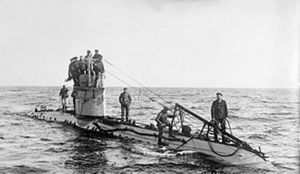
لغواصات النووية. في عام 1954م، أدخلت البحرية الأمريكية في خدمتها الفعلية أول غواصة تعمل بالقدرة النووية، وأُطلق عليها اسم نوتيلوس. وفي أول رحلة بحرية لها، حطمت تلك الغواصة كل الأرقام القياسية السابقة لسرعة سير الغواصات تحت المياه، ودرجة تحملها. وفي عام 1958م، أصبحت الغواصة نوتيلوس أول غواصة تَبْحر تحت ثلوج القطب الشمالي. وفي عام 1960م كانت الغواصة الامريكية تريتون أول غواصة تُسافر حول العالم تحت المياه.
طوَّرت البحرية الأمريكية في أوائل الستينيات من القرن العشرين أول غواصات حديثة لإطلاق الصواريخ البالستية، وكانت كل غواصة منها تحمل 16 صاروخًا من صواريخ بولاريس، وتحمل أسلحة نووية خلف الشراع. وكان بإمكان الطراز الأول لصواريخ بولاريس أن تضْرب أهدافًا تصل إلى بُعد 1930كم. وقد طُورت هذه الصواريخ فيما بعد ليزداد إصابتها إلى 4,500كم.
دخلت أول غواصة نووية في الخدمة الفعلية للبحرية البريطانية في 1963م، وهي الغواصة إتش إم إس دريد نوت. أما الطراز الأكثر تطورًا منها وهو الغواصة إتش إم إس رزوليوشن، التي حملت أول صاروخ بولاريس نووي، فقد دخلت الخدمة في عام 1967م.
وفي عام 1981م، صنعت الولايات المتحدة أول جيل من الغواصات أوهايو. وتُعتبر تلك الغواصات أكبر وأقوى الغواصات التي بنتها الولايات المتحدة حتي الآن، حيث تبلغ 170 مترًا طولاً وتحمل 24 من صواريخ ترايدنت، يبلغ مدى كل صاروخ منها حوالي 6,400كم. ويمكن أن يحتوي على عدة رؤوس نووية مستقلة يمكن توجيه كل منها إلى هدف مُنْفصل. وتُخطط الحكومة البريطانية لإحلال صواريخ ترايدنت محل صواريخ بولاريس في التسعينات من القرن العشرين.
وقبل تفككه في عام 1991م كان الاتحاد السوفييتي يمتلك أكبر غواصات الصواريخ البالستية حجمًا. وكانت صواريخ تلك الغواصات تضرب أهدافًا على بعد يصل إلى 8,000كم. وامتلك الاتحاد السوفييتي أيضًا أسطولاً من الغواصات النووية ـ 310 غواصة ـ زاد عددها على أي دولة أخرى، وتلتها الولايات المتحدة الأمريكية. وفي عام 1992م، دشـّنت روسيا، وتبعتها أوكرانيا، أسطولها من الغواصات. وقد ضمت روسيا معظم الغواصات التي كان يمتلكها الاتحاد السوفيتي السابق. ومن الدول الأخرى التي تمتلك الغواصات النووية الصين وفرنسا وبريطانيا.
وكانت البحرية الملكية لبريطانيا أول بحرية في العالم تستخدم الغواصات النووية في القتال عندما استخدمتها أثناء الصراع بين بريطانيا والأرجنتين حول جزر فوكلاند عام 1982.
وفي أغسطس 2000، غرقت الغواصة النووية كورسك في بحر بارنتس، ومات جميع ملاحيها البالغ عددهم 118 ملاحاً. ظل سبب غرق هذه الغواصة مجهولاً.
أنواع الغواصات
هنالك نوعان رئيسيان من الغواصات هما:
الغواصة الهجومية
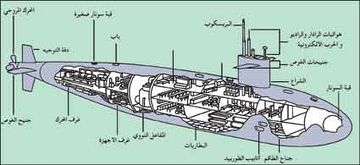
الغواصات الهجومية هي غواصة تصمم للبحث عن غواصات العدو وسفنه وتدميرها. ويتراوح طول معظم الغواصات الهجومية ما بين حوالي 75 و110م. أما أعضاء طاقمها فيصل عددهم إلى 110. وتعمل معظم هذه الغواصات بمحركات تدار بالقدرة النووية وتسلح بطوربيدات وقذائف موجهة.
وتعمل الغواصات الهجومية بصفة رئيسية على اقتناص غواصات العدو، إذ تتابع وتكتشف أهدافها بالسونار، وهو جهاز لاكتشاف الأصوات التي تصدرها الأجسام تحت الماء. أما البريسكوب والرادار فيستخدمان للتعرف على السفن المعادية على سطح الماء. انظر: السونار.
وتطلق الغواصات الهجومية الحديثة طوربيداتها من أنابيب موجودة على امتداد جانبي البدن. ولهذه الطوربيدات أجهزة توجيه تتابع الهدف وتوجه الطوربيد لضربه. وبينما تحتوي مقدمة الغواصات القديمة على أنابيب الطوربيد، فهي تحتوي في الغواصات الحديثة على السونار الذي يكون في هذه الحالة بعيدًا عن ضوضاء المحرك المروحي للغواصة.
وتستطيع بعض الغواصات إطلاق قذائف مضادة للغواصات من أنابيب طوربيد. وهذه الصواريخ بالستية قصيرة المدى لها رؤوس نووية قادرة على تدمير الغواصات الغاطسة تحت الماء من بعد 50كم. وتستطيع بعض الغواصات الأخرى مهاجمة سفن السطح وأهداف الشاطىء بالصواريخ الطوافة (صواريخ كروز) ذات الأجنحة القصيرة التي تنفتح مع بداية الانطلاق. والمعروف أن الصواريخ الطوافة يمكن أن توجه لتفادي دفاعات العدو.
غواصات الصواريخ البالستية
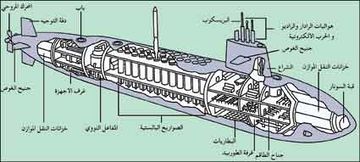
غواصات الصواريخ البالستية هي غواصات تبقى مختفية في الأعماق إلى أن تحين الفرصة المناسبة للهجوم. وهذه الغواصات أكبر حجماً من الغواصات الهجومية، إذ يتراوح طولها بين 115 و 170م، كما يصل عدد أفراد طاقمها إلى حوالي 150 رجلاً. وتحمل غواصات الصواريخ البالستية صواريخ بعيدة المدى لقصف مدن العدو وقواعده العسكرية المطلة على الساحل. وتُطلق الصواريخ من صوامع (منصات إطلاق) موجودة في بدن الغواصة. وتستطيع تلك الصواريخ إصابة أهدافها من بعد يتراوح بين 2,400 و 6,400كم، كما تستطيع أن تحمل قنابل متعددة لإصابة عدة أهداف في آن واحد، إضافة إلى أنها تحمل طوربيدات للدفاع ضد سفن العدو المضادة للغواصات.
وهنالك جهاز خاص على ظهر الغواصة يحدد موقعها على وجه الدقة، ويعين مسار الصاروخ البالستي نحو هدفه. هذا الجهاز المسمى نظام الملاحة بالقصور الذاتي، يتألف من أجهزة قياس دقيقة موصولة بحواسيب. ويساعد هذا النظام الغواصة من خلال تسجيل نقطة بدئها في الرحلة وتحركاتها في الاتجاهات كافة. وهذه المعلومات تُغذي بدورها نظام توجيه الصاروخ ليحدَّد بمقتضاها بُعدُه عن الهدف واتجاهه إليه بدقة. وبعد إطلاق الصاروخ يعمل نظام الملاحة بالقصور الذاتي فيه بتوجيهه نحو الهدف.
وحدة توليد القدرة
يتألف محرك الغواصة النووية من مفاعل نووي ومولد بخار. يستخدم المفاعل اليورانيوم وقودًا، ويشطر ذرات اليورانيوم من خلال عملية تخضع لمراقبة دقيقة تسمى الانشطار . وينتج عن هذه العملية حرارة شديدة. انظر: الطاقة النووية.
وتقوم أنابيب معينة بحمل الماء من مولد البخار إلى المفاعل، حيث يسخن الماء إلى حوالي 320°م. ولأن هذا الماء المسخن مسبقًا يقع تحت ضغط عال، فهو لا يغلي، بل يرجع عوضًا عن ذلك إلى مولد البخار، ويعمل على تسخين مخزون من الماء غير مضغوط ويحيله إلى بخار. وهذا البخار يعمل بدوره على تدوير توربينات ضخمة لتوليد قدرة كافية لتدوير المحرك المروحي الدفع وتشغيل الغواصة.
تعمل المحركات النووية دون الحاجة إلى هواء وتستهلك وقودًا أقل بكثير من ذلك الذي تستهلكه المحركات الأخرى، حيث ينتج 1,8 كجم من وقود اليورانيوم طاقة أكثر من تلك التي ينتجها 38 مليون لتر من زيت الوقود.
وتسير بعض الغواصات بمحركات تعمل بالديزل. ونظرًا لأن محركات الديزل تحرق زيت الوقود فهي تحتاج في عملية الاحتراق إلى هواء. ولذلك لا تستخدم تلك الغواصات المحركات إلا عندما تكون على سطح الماء أو بالقرب منه. وتستمد الغواصة قدرتها من بطاريات عندما تكون تحت سطح الماء. وفي الفترة الأخيرة من الحرب العالمية الثانية (1939 - 1945م)، جهزت البحرية الألمانية غواصاتها بأنبوب تنفس يسمى المنشاق. وقد عمل المنشاق على إدخال الهواء إلى الغواصة عند وجودها بالقرب من السطح. وحل هذا الهواء محل الأكسجين الذي تستخدمه محركات الديزل ويتنفسه طاقم الغواصة. غير أن المنشاق كان يخلف أثرًا في الماء مما كان يساعد على اكتشاف موقع الغواصة. ولذلك فإن الغواصات لم تصبح سفنًا تحت مائية حقًا إلا بعد تطوير القدرة النووية.
فكرة عمل الغواصة وتطورها
فكره عمل الغواصات الحديثه تعتمد على قانون أرخميدس للطفو. فالغواصات الحديثه تحتوى على حاويات يتم من خلالها التحكم في كثافه الغواصه و من ثم التحكم في عمقها في الماء. و تختلف اشكال الحاويات من غواصه لأخرى كما هو موضح بالرسومات.
العمل على السطح
عندما تكون الغواصة على سطح الماء، فإنها تعمل كأية سفينة أخرى. وتستطيع الغواصة أن تسير على سطح الماء بسرعة 20 عقدة (ميلاً بحريًا) في الساعة. ومهما يكن من أمر فإن الغواصات الحديثة لا تقضي وقتًا يذكر على سطح الماء.
الغوص
تغوص الغواصة بإغراق خزان ثقلها الموازن بالماء، حيث يفقد الوزن المضاف الغواصة قابليتها الإيجابية للطفو، ويجعل تلك القابلية محيَّدة تمامًا. وبعدئذ تمال جنيحات الغوص إلى أسفل لتشق الغواصة طريقها بيسر نحو عمق الماء.
تستطيع الغواصة أن تغوص إلى عمق 30م في أقل من دقيقة واحدة. ولا تصل إلى أكثر من عمق حوالي 900م إلا غواصات البحث العلمي المصممة خصيصًا لهذا الغرض. وتستطيع هذه الغواصات مقاومة الضغط الشديد الذي يمكن أن يسحق الغواصات العادية في ثوان. والفلزات المستخدمة في غواصات البحث العلمي أثقل من التي تستخدم في الغواصات القتالية، كما أن تقنيات التصميم المستخدمة فيها باهظة التكاليف .
العمليات تحت الماء
تسير الغواصة تحت الماء كما تسير الطائرة في الجو تريبًا، إذ تتخذ جنيحات الغوص زوايا مختلفة صعودًا وهبوطًا لرفع أو خفض الغواصة. ويجلس اثنان من أفراد الطاقم أمام لوحة تحكم شبيهة بلوحة التحكم في الطائرة لمناورة الغواصة، فيدفعان بعجلة التحكم إلى الأمام إذا أرادا الهبوط أو يسحبانها إذا أرادا الصعود بالغواصة. كما أن إدارة العجلة إلى اليمين أو اليسار يحرك دفة التوجيه لتغيير اتجاه الغواصة حسب الاتجاه المطلوب.
وتستطيع الغواصة النووية أن تسير تحت الماء بسرعة تزيد على 30 عقدة. وبينما يصدر جهاز السونار تحذيرًا ضد أية عوائق في الطريق، يعطي نظام التوجيه بالقصور الذاتي معلومات عن موقعها على وجه الدقة. وتستطيع أسرع الغواصات أن تسير بسرعة 43 عقدة تحت الماء.
الخروج إلى السطح
نخرج الغواصة إلى سطح الماء بإحدى طريقتين: بإخراج الماء من خزانات الثقل الموازن بالهواء المضغوط، أو بإمالة جنيحات الغوص بطريقة تجعل الغواصة متجهة إلى أعلى.
الحياة داخل الغواصة
تخرج الغواصات الهجومية في دورية لعدة شهور، وكثيراً ما تتوقف في موانئ معينة في تلك الرحلة. أما غواصات الصواريخ البالستية فتستمر دوريتها لمدة 60 يومًا، وتكاد تبقى خلال كل تلك الفترة تحت الماء. وفي كلا النوعين من الغواصات يتوافر لدى الملاحين شتى سُبل الراحة والترفيه أثناء الرحلة. فعلى سبيل المثال، هناك وحدات تكييف الهواء الضخمة للمحافظة على الحرارة والرطوبة في مستوى مريح، وهناك مكتبات وغرف للتسلية تيسر كثيرًا من رتابة الحياة في أعماق البحر.
وفي معظم الغواصات، يجب على كل فرد من أفراد الطاقم أن يعمل في نوبة لمدة 4 ساعات تُسمى نوبة الحراسة. وبعد الفراغ من نوبته يسلم فرد الطاقم العمل لفرد آخر، ويبتعد عن العمل لمدة ثماني ساعات. وفي تلك الفترة قد يقوم ببعض أعمال الصيانة في السفينة، ولكنه يتمتع بحرية كاملة لنيل قسط من الراحة أو للقراءة حتى يعود إلى العمل مرة أخرى. وتتغير واجبات العمل على نحو يهيىء لأفراد الطاقم كافة عطلة لعدة أيام .
تملك الغواصات النووية القدرة على إنتاج هوائها الخاص وماء الشرب. فعن طريق العملية المسماة التحليل الكهربائي يتم استخلاص الأكسجين من ماء البحر وتوفير الهواء اللازم للطاقم. وتعمل مصفيات كيميائية خاصة على تنقية الهواء من العناصر الضارة داخل الغواصة. وهناك صفائح رصاصية تغلف المفاعل النووي لوقاية الطاقم من خطر الإشعاع. ويُقطر ماء الشرب النقي من ماء البحر بآلات خاصة.
تعود الغواصة إلى الميناء، بعد الانتهاء من رحلتها، وهناك تجرى عليها الصيانة اللازمة وتزود بمزيد من المؤن. أما غواصة الصواريخ البالستية فتستبدل طواقمها أيضًا. ولغواصة الصواريخ البالستية في العادة طاقمان، يحل أحدهما محل الآخر بعد أن يكمل نوبته، ومن ثم يخرج الطاقم الجديد بالغواصة في مهمة أخرى. أما العائدون إلى الشاطىء فيذهبون في عطلة يتلقون فيها مزيداً من التدريب. وبعد أن يكمل طاقم الغواصة الهجومية نوبتهم، تربض الغواصة لعدة شهور أو تقتصر على عمليات محلية.
الاستخدام
العسكري

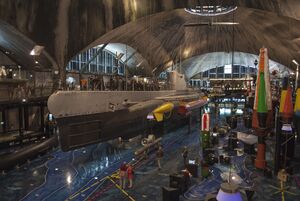
Before and during World War II, the primary role of the submarine was anti-surface ship warfare. Submarines would attack either on the surface using deck guns, or submerged using torpedoes. They were particularly effective in sinking Allied transatlantic shipping in both World Wars, and in disrupting Japanese supply routes and naval operations in the Pacific in World War II.
Mine-laying submarines were developed in the early part of the 20th century. The facility was used in both World Wars. Submarines were also used for inserting and removing covert agents and military forces in special operations, for intelligence gathering, and to rescue aircrew during air attacks on islands, where the airmen would be told of safe places to crash-land so the submarines could rescue them. Submarines could carry cargo through hostile waters or act as supply vessels for other submarines.
Submarines could usually locate and attack other submarines only on the surface, although إتشإمإس Venturer managed to sink U-864 with a four torpedo spread while both were submerged. The British developed a specialized anti-submarine submarine in WWI, the R class. After WWII, with the development of the homing torpedo, better sonar systems, and nuclear propulsion, submarines also became able to hunt each other effectively.
The development of submarine-launched ballistic missile and submarine-launched cruise missiles gave submarines a substantial and long-ranged ability to attack both land and sea targets with a variety of weapons ranging from cluster bombs to nuclear weapons.
The primary defense of a submarine lies in its ability to remain concealed in the depths of the ocean. Early submarines could be detected by the sound they made. Water is an excellent conductor of sound (much better than air), and submarines can detect and track comparatively noisy surface ships from long distances. Modern submarines are built with an emphasis on stealth. Advanced propeller designs, extensive sound-reducing insulation, and special machinery help a submarine remain as quiet as ambient ocean noise, making them difficult to detect. It takes specialized technology to find and attack modern submarines.
Active sonar uses the reflection of sound emitted from the search equipment to detect submarines. It has been used since WWII by surface ships, submarines and aircraft (via dropped buoys and helicopter "dipping" arrays), but it reveals the emitter's position, and is susceptible to counter-measures.
A concealed military submarine is a real threat, and because of its stealth, can force an enemy navy to waste resources searching large areas of ocean and protecting ships against attack. This advantage was vividly demonstrated in the 1982 Falklands War when the British nuclear-powered submarine إتشإمإس Conqueror sank the Argentine cruiser General Belgrano. After the sinking the Argentine Navy recognized that they had no effective defense against submarine attack, and the Argentine surface fleet withdrew to port for the remainder of the war. An Argentine submarine remained at sea, however.[5]
المدني
Although the majority of the world's submarines are military, there are some civilian submarines, which are used for tourism, exploration, oil and gas platform inspections, and pipeline surveys. Some are also used in illegal activities.
The Submarine Voyage ride opened at Disneyland in 1959, but although it ran under water it was not a true submarine, as it ran on tracks and was open to the atmosphere.[6] The first tourist submarine was Auguste Piccard, which went into service in 1964 at Expo64.[7] By 1997 there were 45 tourist submarines operating around the world.[8] Submarines with a crush depth in the range of 400–500 أقدام (120–150 m) are operated in several areas worldwide, typically with bottom depths around 100 إلى 120 أقدام (30 إلى 37 m), with a carrying capacity of 50 to 100 passengers.
In a typical operation a surface vessel carries passengers to an offshore operating area and loads them into the submarine. The submarine then visits underwater points of interest such as natural or artificial reef structures. To surface safely without danger of collision the location of the submarine is marked with an air release and movement to the surface is coordinated by an observer in a support craft.
A recent development is the deployment of so-called narco-submarines by South American drug smugglers to evade law enforcement detection.[9] Although they occasionally deploy true submarines, most are self-propelled semi-submersibles, where a portion of the craft remains above water at all times. In September 2011, Colombian authorities seized a 16-meter-long submersible that could hold a crew of 5, costing about $2 million. The vessel belonged to FARC rebels and had the capacity to carry at least 7 tonnes of drugs.[10]
- Civilian submarines
Model of the Mésoscaphe Auguste Piccard
Interior of the tourist submarine Atlantis whilst submerged
العمليات القطبية
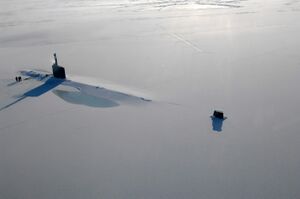
- 1903 – Simon Lake submarine Protector surfaced through ice off Newport, Rhode Island.[11]
- 1930 – يوإسإس O-12 operated under ice near Spitsbergen.[11]
- 1937 – Soviet submarine Krasnogvardeyets operated under ice in the Denmark Strait.[11]
- 1941–45 – German U-boats operated under ice from the Barents Sea to the Laptev Sea.[11]
- 1946 – يوإسإس Atule used upward-beamed fathometer in Operation Nanook in the Davis Strait.[11]
- 1946–47 – يوإسإس Sennet used under-ice sonar in Operation High Jump in the Antarctic.[11]
- 1947 – يوإسإس Boarfish used upward-beamed echo sounder under pack ice in the Chukchi Sea.[11]
- 1948 – يوإسإس Carp developed techniques for making vertical ascents and descents through polynyas in the Chukchi Sea.[11]
- 1952 – يوإسإس Redfish used an expanded upward-beamed sounder array in the Beaufort Sea.[11]
- 1957 – يوإسإس Nautilus reached 87 degrees north near Spitsbergen.[11]
- 3 August 1958 – Nautilus used an inertial navigation system to reach the North Pole.[11]
- 17 March 1959 – يوإسإس Skate surfaced through the ice at the north pole.[11]
- 1960 – يوإسإس Sargo transited 900 ميل (1،400 km) under ice over the shallow (125 إلى 180 أقدام أو 38 إلى 55 متر deep) Bering-Chukchi shelf.[11]
- 1960 – يوإسإس Seadragon transited the Northwest Passage under ice.[11]
- 1962 – Soviet November، طراز submarine K-3 Leninsky Komsomol reached the north pole.[11]
- 1970 – يوإسإس Queenfish carried out an extensive undersea mapping survey of the Siberian continental shelf.[12]
- 1971 – إتشإمإس Dreadnought reached the North Pole.[11]
- يوإسإس Gurnard conducted three Polar Exercises: 1976 (with US actor Charlton Heston aboard); 1984 joint operations with يوإسإس Pintado; and 1990 joint exercises with يوإسإس Seahorse.[13]
- 6 May 1986 – يوإسإس Ray, يوإسإس Archerfish and يوإسإس Hawkbill meet and surface together at the Geographic North Pole. First three-submarine surfacing at the Pole.[14]
- 19 May 1987 – إتشإمإس Superb joined يوإسإس Billfish and يوإسإس Sea Devil at the North Pole.[15]
- March 2007 – يوإسإس Alexandria participated in the Joint US Navy/Royal Navy Ice Exercise 2007 (ICEX-2007) in the Arctic Ocean with the Trafalgar، طراز submarine إتشإمإس Tireless.[16]
- March 2009 – يوإسإس Annapolis took part in Ice Exercise 2009 to test submarine operability and war-fighting capability in Arctic conditions.[17]
التكنولوجيا
الطفو والتقليم
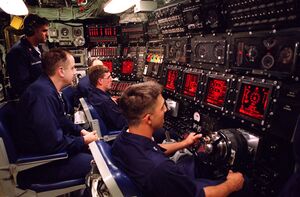
All surface ships, as well as surfaced submarines, are in a positively buoyant condition, weighing less than the volume of water they would displace if fully submerged. To submerge hydrostatically, a ship must have negative buoyancy, either by increasing its own weight or decreasing its displacement of water. To control their displacement and weight, submarines have ballast tanks, which can hold varying amounts of water and air.[18]
For general submersion or surfacing, submarines use the main ballast tanks (MBTs), which are ambient pressure tanks, filled with water to submerge, or with air to surface. While submerged, MBTs generally remain flooded, which simplifies their design,[18] and on many submarines these tanks are a section of the space between the light hull and the pressure hull. For more precise control of depth, submarines use smaller depth control tanks (DCTs)—also called hard tanks (due to their ability to withstand higher pressure), or trim tanks. These are variable buoyancy pressure vessels, a type of buoyancy control device. The amount of water in depth control tanks can be adjusted to hydrostatically change depth or to maintain a constant depth as outside conditions (mainly water density) change.[18] Depth control tanks may be located either near the submarine's center of gravity, to minimise the effect on trim, or separated along the length of the hull so they can also be used to adjust static trim by transfer of water between them.
When submerged, the water pressure on a submarine's hull can reach 4 MPa (580 psi) for steel submarines and up to 10 MPa (1،500 psi) for titanium submarines like K-278 Komsomolets, while interior pressure remains relatively unchanged. This difference results in hull compression, which decreases displacement. Water density also marginally increases with depth, as the salinity and pressure are higher.[19] This change in density incompletely compensates for hull compression, so buoyancy decreases as depth increases. A submerged submarine is in an unstable equilibrium, having a tendency to either sink or float to the surface. Keeping a constant depth requires continual operation of either the depth control tanks or control surfaces.[20][21]
Submarines in a neutral buoyancy condition are not intrinsically trim-stable. To maintain desired longitudinal trim, submarines use forward and aft trim tanks. Pumps move water between the tanks, changing weight distribution and pitching the sub up or down. A similar system may be used to maintain transverse trim.[18]
أسطح التحكم
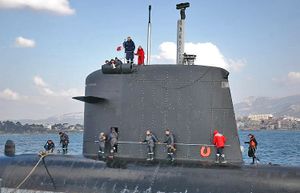
The hydrostatic effect of variable ballast tanks is not the only way to control the submarine underwater. Hydrodynamic maneuvering is done by several control surfaces, collectively known as diving planes or hydroplanes, which can be moved to create hydrodynamic forces when a submarine moves longitudinally at sufficient speed. In the classic cruciform stern configuration, the horizontal stern planes serve the same purpose as the trim tanks, controlling the trim. Most submarines additionally have forward horizontal planes, normally placed on the bow until the 1960s but often on the sail on later designs, where they are closer to the center of gravity and can control depth with less effect on the trim.[22]
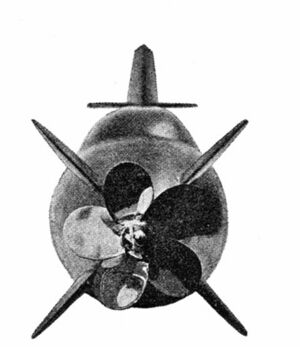
An obvious way to configure the control surfaces at the stern of a submarine is to use vertical planes to control yaw and horizontal planes to control pitch, which gives them the shape of a cross when seen from astern of the vessel. In this configuration, which long remained the dominant one, the horizontal planes are used to control the trim and depth and the vertical planes to control sideways maneuvers, like the rudder of a surface ship.
Alternatively, the rear control surfaces can be combined into what has become known as an x-stern or an x-rudder. Although less intuitive, such a configuration has turned out to have several advantages over the traditional cruciform arrangement. First, it improves maneuverability, horizontally as well as vertically.[مطلوب توضيح] Second, the control surfaces are less likely to get damaged when landing on, or departing from, the seabed as well as when mooring and unmooring alongside. Finally, it is safer in that one of the two diagonal lines can counteract the other with respect to vertical as well as horizontal motion if one of them accidentally gets stuck.[23][مطلوب توضيح]
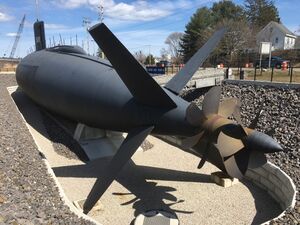
The x-stern was first tried in practice in the early 1960s on the USS Albacore, an experimental submarine of the US Navy. While the arrangement was found to be advantageous, it was nevertheless not used on US production submarines that followed due to the fact that it requires the use of a computer to manipulate the control surfaces to the desired effect.[24] Instead, the first to use an x-stern in standard operations was the Swedish Navy with its Sjöormen class, the lead submarine of which was launched in 1967, before the Albacore had even finished her test runs.[25] Since it turned out to work very well in practice, all subsequent classes of Swedish submarines (Näcken, Västergötland, Gotland, and Blekinge class) have or will come with an x-rudder.
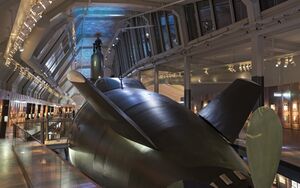
The Kockums shipyard responsible for the design of the x-stern on Swedish submarines eventually exported it to Australia with the Collins class as well as to Japan with the Sōryū class. With the introduction of the type 212, the German and Italian Navies came to feature it as well. The US Navy with its Columbia class, the British Navy with its Dreadnought class, and the French Navy with its Barracuda class are all about to join the x-stern family. Hence, as judged by the situation in the early 2020s, the x-stern is about to become the dominant technology.
When a submarine performs an emergency surfacing, all depth and trim control methods are used simultaneously,[بحاجة لمصدر] together with propelling the boat upwards. Such surfacing is very quick, so the sub may even partially jump out of the water, potentially damaging submarine systems.[مطلوب توضيح]
البدن
استعراض
Modern submarines are cigar-shaped. This design, also used in very early submarines, is sometimes called a "teardrop hull". It reduces hydrodynamic drag when the sub is submerged, but decreases the sea-keeping capabilities and increases drag while surfaced. Since the limitations of the propulsion systems of early submarines forced them to operate surfaced most of the time, their hull designs were a compromise. Because of the slow submerged speeds of those subs, usually, well below 10 kt (18 km/h), the increased drag for underwater travel was acceptable. Late in World War II, when technology allowed faster and longer submerged operation and increased aircraft surveillance forced submarines to stay submerged, hull designs became teardrop shaped again to reduce drag and noise. يوإسإس Albacore (AGSS-569) was a unique research submarine that pioneered the American version of the teardrop hull form (sometimes referred to as an "Albacore hull") of modern submarines. On modern military submarines the outer hull is covered with a layer of sound-absorbing rubber, or anechoic plating, to reduce detection.
The occupied pressure hulls of deep-diving submarines such as DSV Alvin are spherical instead of cylindrical. This allows a more even distribution of stress and efficient use of materials to withstand external pressure as it gives the most internal volume for structural weight and is the most efficient shape to avoid buckling instability in compression. A frame is usually affixed to the outside of the pressure hull, providing attachment for ballast and trim systems, scientific instrumentation, battery packs, syntactic flotation foam, and lighting.
A raised tower on top of a standard submarine accommodates the periscope and electronics masts, which can include radio, radar, electronic warfare, and other systems. It might also include a snorkel mast. In many early classes of submarines (see history), the control room, or "conn", was located inside this tower, which was known as the "conning tower". Since then, the conn has been located within the hull of the submarine, and the tower is now called the "sail" or "fin". The conn is distinct from the "bridge", a small open platform in the top of the sail, used for observation during surface operation.
"Bathtubs" are related to conning towers but are used on smaller submarines. The bathtub is a metal cylinder surrounding the hatch that prevents waves from breaking directly into the cabin. It is needed because surfaced submarines have limited freeboard, that is, they lie low in the water. Bathtubs help prevent swamping the vessel.
أحادية وثنائية البدن
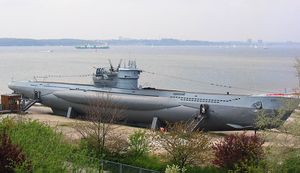
Modern submarines and submersibles usually have, as did the earliest models, a single hull. Large submarines generally have an additional hull or hull sections outside. This external hull, which actually forms the shape of submarine, is called the outer hull (casing in the Royal Navy) or light hull, as it does not have to withstand a pressure difference. Inside the outer hull there is a strong hull, or pressure hull, which withstands sea pressure and has normal atmospheric pressure inside.
As early as World War I, it was realized that the optimal shape for withstanding pressure conflicted with the optimal shape for seakeeping and minimal drag at the surface, and construction difficulties further complicated the problem. This was solved either by a compromise shape, or by using two layered hulls: the internal strength hull for withstanding pressure, and an external fairing for hydrodynamic shape. Until the end of World War II, most submarines had an additional partial casing on the top, bow and stern, built of thinner metal, which was flooded when submerged. Germany went further with the Type XXI, a general predecessor of modern submarines, in which the pressure hull was fully enclosed inside the light hull, but optimized for submerged navigation, unlike earlier designs that were optimized for surface operation.
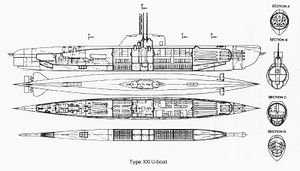
After World War II, approaches split. The Soviet Union changed its designs, basing them on German developments. All post-World War II heavy Soviet and Russian submarines are built with a double hull structure. American and most other Western submarines switched to a primarily single-hull approach. They still have light hull sections in the bow and stern, which house main ballast tanks and provide a hydrodynamically optimized shape, but the main cylindrical hull section has only a single plating layer. Double hulls are being considered for future submarines in the United States to improve payload capacity, stealth and range.[26]
بدن الضغط
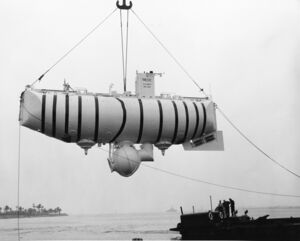
The pressure hull is generally constructed of thick high-strength steel with a complex structure and high strength reserve, and is separated by watertight bulkheads into several compartments. There are also examples of more than two hulls in a submarine, like the Typhoon طراز, which has two main pressure hulls and three smaller ones for control room, torpedoes and steering gear, with the missile launch system between the main hulls, all surrounded and supported by the outer light hydrodynamic hull. When submerged the pressure hull provides most of the buoyancy for the whole vessel.
The dive depth cannot be increased easily. Simply making the hull thicker increases the structural weight and requires reduction of onboard equipment weight, and increasing the diameter requires a proportional increase in thickness for the same material and architecture, ultimately resulting in a pressure hull that does not have sufficient buoyancy to support its own weight, as in a bathyscaphe. This is acceptable for civilian research submersibles, but not military submarines, which need to carry a large equipment, crew, and weapons load to fulfill their function. Construction materials with greater specific strength and specific modulus are needed.
WWI submarines had hulls of carbon steel, with a 100-متر (330 ft) maximum depth. During WWII, high-strength alloyed steel was introduced, allowing 200-متر (660 ft) depths. High-strength alloy steel remains the primary material for submarines today, with 250–400-متر (820–1،310 ft) depths, which cannot be exceeded on a military submarine without design compromises. To exceed that limit, a few submarines were built with titanium hulls. Titanium alloys can be stronger than steel, lighter, and most importantly, have higher immersed specific strength and specific modulus. Titanium is also not ferromagnetic, important for stealth. Titanium submarines were built by the Soviet Union, which developed specialized high-strength alloys. It has produced several types of titanium submarines. Titanium alloys allow a major increase in depth, but other systems must be redesigned to cope, so test depth was limited to 1،000 متر (3،300 ft) for the Soviet submarine K-278 Komsomolets, the deepest-diving combat submarine. An Alfa، طراز submarine may have successfully operated at 1،300 متر (4،300 ft),[27] though continuous operation at such depths would produce excessive stress on many submarine systems. Titanium does not flex as readily as steel, and may become brittle after many dive cycles. Despite its benefits, the high cost of titanium construction led to the abandonment of titanium submarine construction as the Cold War ended. Deep-diving civilian submarines have used thick acrylic pressure hulls. Although the specific strength and specific modulus of acrylic are not very high, the density is only 1.18g/cm3, so it is only very slightly denser than water, and the buoyancy penalty of increased thickness is correspondingly low.
The deepest deep-submergence vehicle (DSV) to date is Trieste. On 5 October 1959, Trieste departed San Diego for Guam aboard the freighter Santa Maria to participate in Project Nekton, a series of very deep dives in the Mariana Trench. On 23 January 1960, Trieste reached the ocean floor in the Challenger Deep (the deepest southern part of the Mariana Trench), carrying Jacques Piccard (son of Auguste) and Lieutenant Don Walsh, USN.[28] This was the first time a vessel, crewed or uncrewed, had reached the deepest point in the Earth's oceans. The onboard systems indicated a depth of 11،521 متر (37،799 ft), although this was later revised to 10،916 متر (35،814 ft) and more accurate measurements made in 1995 have found the Challenger Deep slightly shallower, at 10،911 متر (35،797 ft).
Building a pressure hull is difficult, as it must withstand pressures at its required diving depth. When the hull is perfectly round in cross-section, the pressure is evenly distributed, and causes only hull compression. If the shape is not perfect, the hull deflects more in some places and buckling instability is the usual failure mode. Inevitable minor deviations are resisted by stiffener rings, but even a one-inch (25 mm) deviation from roundness results in over 30 percent decrease of maximal hydrostatic load and consequently dive depth.[29] The hull must therefore be constructed with high precision. All hull parts must be welded without defects, and all joints are checked multiple times with different methods, contributing to the high cost of modern submarines. (For example, each Virginia، طراز attack submarine costs US$2.6 billion, over US$200,000 per ton of displacement.)
الدفع
The first submarines were propelled by humans. The first mechanically driven submarine was the 1863 French Plongeur, which used compressed air for propulsion. Anaerobic propulsion was first employed by the Spanish Ictineo II in 1864, which used a solution of zinc, manganese dioxide, and potassium chlorate to generate sufficient heat to power a steam engine, while also providing oxygen for the crew. A similar system was not employed again until 1940 when the German Navy tested a hydrogen peroxide-based system, the Walter turbine, on the experimental V-80 submarine and later on the naval U-791 and type XVII submarines;[30] the system was further developed for the British Explorer، طراز, completed in 1958.[31]
Until the advent of nuclear marine propulsion, most 20th-century submarines used electric motors and batteries for running underwater and combustion engines on the surface, and for battery recharging. Early submarines used gasoline (petrol) engines but this quickly gave way to kerosene (paraffin) and then diesel engines because of reduced flammability and, with diesel, improved fuel-efficiency and thus also greater range. A combination of diesel and electric propulsion became the norm.
Initially, the combustion engine and the electric motor were in most cases connected to the same shaft so that both could directly drive the propeller. The combustion engine was placed at the front end of the stern section with the electric motor behind it followed by the propeller shaft. The engine was connected to the motor by a clutch and the motor in turn connected to the propeller shaft by another clutch.
With only the rear clutch engaged, the electric motor could drive the propeller, as required for fully submerged operation. With both clutches engaged, the combustion engine could drive the propeller, as was possible when operating on the surface or, at a later stage, when snorkeling. The electric motor would in this case serve as a generator to charge the batteries or, if no charging was needed, be allowed to rotate freely. With only the front clutch engaged, the combustion engine could drive the electric motor as a generator for charging the batteries without simultaneously forcing the propeller to move.
The motor could have multiple armatures on the shaft, which could be electrically coupled in series for slow speed and in parallel for high speed (these connections were called "group down" and "group up", respectively).
نقل القدرة الديزل-الكهرباء
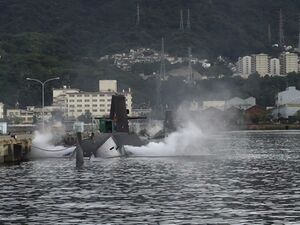
While most early submarines used a direct mechanical connection between the combustion engine and the propeller, an alternative solution was considered as well as implemented at a very early stage.[32] That solution consists in first converting the work of the combustion engine into electric energy via a dedicated generator. This energy is then used to drive the propeller via the electric motor and, to the extent required, for charging the batteries. In this configuration, the electric motor is thus responsible for driving the propeller at all times, regardless of whether air is available so that the combustion engine can also be used or not.
Among the pioneers of this alternative solution was the very first submarine of the Swedish Navy, HMS Hajen (later renamed Ub no 1), launched in 1904. While its design was generally inspired by the first submarine commissioned by the US Navy, USS Holland, it deviated from the latter in at least three significant ways: by adding a periscope, by replacing the gasoline engine by a semidiesel engine (a hot-bulb engine primarily meant to be fueled by kerosene, later replaced by a true diesel engine) and by severing the mechanical link between the combustion engine and the propeller by instead letting the former drive a dedicated generator.[33] By so doing, it took three significant steps toward what was eventually to become the dominant technology for conventional (i.e., non-nuclear) submarines.

In the following years, the Swedish Navy added another seven submarines in three different classes (2nd class, Laxen class, and Braxen class) using the same propulsion technology but fitted with true diesel engines rather than semidiesels from the outset.[34] Since by that time, the technology was usually based on the diesel engine rather than some other type of combustion engine, it eventually came to be known as diesel–electric transmission.
Like many other early submarines, those initially designed in Sweden were quite small (less than 200 tonnes) and thus confined to littoral operation. When the Swedish Navy wanted to add larger vessels, capable of operating further from the shore, their designs were purchased from companies abroad that already had the required experience: first Italian (Fiat-Laurenti) and later German (A.G. Weser and IvS).[35] As a side-effect, the diesel–electric transmission was temporarily abandoned.
However, diesel–electric transmission was immediately reintroduced when Sweden began designing its own submarines again in the mid 1930s. From that point onwards, it has been consistently used for all new classes of Swedish submarines, albeit supplemented by air-independent propulsion (AIP) as provided by Stirling engines beginning with HMS Näcken in 1988.[36]
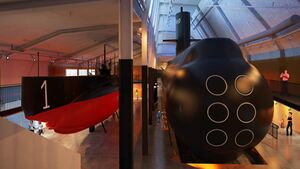
Another early adopter of diesel–electric transmission was the US Navy, whose Bureau of Engineering proposed its use in 1928. It was subsequently tried in the S-class submarines S-3, S-6, and S-7 before being put into production with the Porpoise class of the 1930s. From that point onwards, it continued to be used on most US conventional submarines.[37]
Apart from the British U-class and some submarines of the Imperial Japanese Navy that used separate diesel generators for low speed running, few navies other than those of Sweden and the US made much use of diesel–electric transmission before 1945.[37] After World War II, by contrast, it gradually became the dominant mode of propulsion for conventional submarines. However, its adoption was not always swift. Notably, the Soviet Navy did not introduce diesel–electric transmission on its conventional submarines until 1980 with its Paltus class.[38]
If diesel–electric transmission had only brought advantages and no disadvantages in comparison with a system that mechanically connects the diesel engine to the propeller, it would undoubtedly have become dominant much earlier. The disadvantages include the following:[39][40]
- It entails a loss of fuel-efficiency as well as power by converting the output of the diesel engine into electricity. While both generators and electric motors are known to be very efficient, their efficiency nevertheless falls short of 100 percent.
- It requires an additional component in the form of a dedicated generator. Since the electric motor is always used to drive the propeller it can no longer step in to take on generator service as well.
- It does not allow the diesel engine and the electrical motor to join forces by simultaneously driving the propeller mechanically for maximum speed when the submarine is surfaced or snorkeling. This may, however, be of little practical importance inasmuch as the option it prevents is one that would leave the submarine at a risk of having to dive with its batteries at least partly depleted.
The reason why diesel–electric transmission has become the dominant alternative in spite of these disadvantages is of course that it also comes with many advantages and that, on balance, these have eventually been found to be more important. The advantages include the following:[39][40]
- It reduces external noise by severing the direct and rigid mechanical link between the relatively noisy diesel engine(s) on the one hand and the propeller shaft(s) and hull on the other. With stealth being of paramount importance to submarines, this is a very significant advantage.
- It increases the readiness to dive, which is of course of vital importance for a submarine. The only thing required from a propulsion point of view is to shut down the diesel(s).
- It makes the speed of the diesel engine(s) temporarily independent of the speed of the submarine. This in turn often makes it possible to run the diesel(s) at close to optimal speed from a fuel-efficiency as well as durability point of view. It also makes it possible to reduce the time spent surfaced or snorkeling by running the diesel(s) at maximum speed without affecting the speed of the submarine itself.
- It eliminates the clutches otherwise required to connect the diesel engine, the electric motor, and the propeller shaft. This in turn saves space, increases reliability and reduces maintenance costs.
- It increases flexibility with regard to how the driveline components are configured, positioned, and maintained. For example, the diesel no longer has to be aligned with the electric motor and propeller shaft, two diesels can be used to power a single propeller (or vice versa), and one diesel can be turned off for maintenance as long as a second is available to provide the required amount of electricity.
- It facilitates the integration of additional primary sources of energy, beside the diesel engine(s), such as various kinds of air-independent power (AIP) systems. With one or more electric motors always driving the propeller(s), such systems can easily be introduced as yet another source of electric energy in addition to the diesel engine(s) and the batteries.
Snorkel
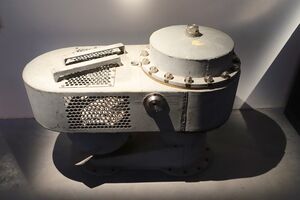
During World War II the Germans experimented with the idea of the schnorchel (snorkel) from captured Dutch submarines but did not see the need for them until rather late in the war. The schnorchel is a retractable pipe that supplies air to the diesel engines while submerged at periscope depth, allowing the boat to cruise and recharge its batteries while maintaining a degree of stealth.
Especially as first implemented however, it turned out to be far from a perfect solution. There were problems with the device's valve sticking shut or closing as it dunked in rough weather. Since the system used the entire pressure hull as a buffer, the diesels would instantaneously suck huge volumes of air from the boat's compartments, and the crew often suffered painful ear injuries. Speed was limited to 8 عقدة (15 km/h), lest the device snap from stress. The schnorchel also created noise that made the boat easier to detect with sonar, yet more difficult for the on-board sonar to detect signals from other vessels. Finally, allied radar eventually became sufficiently advanced that the schnorchel mast could be detected beyond visual range.[41]
While the snorkel renders a submarine far less detectable, it is thus not perfect. In clear weather, diesel exhausts can be seen on the surface to a distance of about three miles,[42] while "periscope feather" (the wave created by the snorkel or periscope moving through the water) is visible from far off in calm sea conditions. Modern radar is also capable of detecting a snorkel in calm sea conditions.[43]
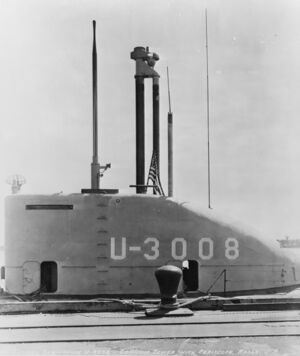
The problem of the diesels causing a vacuum in the submarine when the head valve is submerged still exists in later model diesel submarines but is mitigated by high-vacuum cut-off sensors that shut down the engines when the vacuum in the ship reaches a pre-set point. Modern snorkel induction masts have a fail-safe design using compressed air, controlled by a simple electrical circuit, to hold the "head valve" open against the pull of a powerful spring. Seawater washing over the mast shorts out exposed electrodes on top, breaking the control, and shutting the "head valve" while it is submerged. US submarines did not adopt the use of snorkels until after WWII.[44]
الدفع بدون هواء
During World War II, German Type XXI submarines (also known as "Elektroboote") were the first submarines designed to operate submerged for extended periods. Initially they were to carry hydrogen peroxide for long-term, fast air-independent propulsion, but were ultimately built with very large batteries instead. At the end of the War, the British and Soviets experimented with hydrogen peroxide/kerosene (paraffin) engines that could run surfaced and submerged. The results were not encouraging. Though the Soviet Union deployed a class of submarines with this engine type (codenamed Quebec by NATO), they were considered unsuccessful.
The United States also used hydrogen peroxide in an experimental midget submarine, X-1. It was originally powered by a hydrogen peroxide/diesel engine and battery system until an explosion of her hydrogen peroxide supply on 20 May 1957. X-1 was later converted to use diesel–electric drive.[45]
Today several navies use air-independent propulsion. Notably Sweden uses Stirling technology on the Gotland، طراز and Södermanland، طراز submarines. The Stirling engine is heated by burning diesel fuel with liquid oxygen from cryogenic tanks. A newer development in air-independent propulsion is hydrogen fuel cells, first used on the German Type 212 submarine, with nine 34 kW or two 120 kW cells. Fuel cells are also used in the new Spanish S-80، طراز submarines although with the fuel stored as ethanol and then converted into hydrogen before use.[46]
One new technology that is being introduced starting with the Japanese Navy's eleventh Sōryū-class submarine (JS Ōryū) is a more modern battery, the lithium-ion battery. These batteries have about double the electric storage of traditional batteries, and by changing out the lead-acid batteries in their normal storage areas plus filling up the large hull space normally devoted to AIP engine and fuel tanks with many tons of lithium-ion batteries, modern submarines can actually return to a "pure" diesel–electric configuration yet have the added underwater range and power normally associated with AIP equipped submarines.[بحاجة لمصدر]
الطاقة النووية
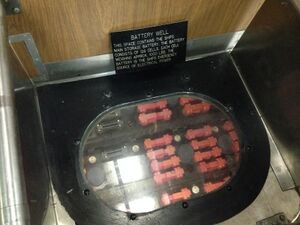
Steam power was resurrected in the 1950s with a nuclear-powered steam turbine driving a generator. By eliminating the need for atmospheric oxygen, the time that a submarine could remain submerged was limited only by its food stores, as breathing air was recycled and fresh water distilled from seawater. More importantly, a nuclear submarine has unlimited range at top speed. This allows it to travel from its operating base to the combat zone in a much shorter time and makes it a far more difficult target for most anti-submarine weapons. Nuclear-powered submarines have a relatively small battery and diesel engine/generator powerplant for emergency use if the reactors must be shut down.
Nuclear power is now used in all large submarines, but due to the high cost and large size of nuclear reactors, smaller submarines still use diesel–electric propulsion. The ratio of larger to smaller submarines depends on strategic needs. The US Navy, French Navy, and the British Royal Navy operate only nuclear submarines,[47][48] which is explained by the need for distant operations. Other major operators rely on a mix of nuclear submarines for strategic purposes and diesel–electric submarines for defense. Most fleets have no nuclear submarines, due to the limited availability of nuclear power and submarine technology.
Diesel–electric submarines have a stealth advantage over their nuclear counterparts. Nuclear submarines generate noise from coolant pumps and turbo-machinery needed to operate the reactor, even at low power levels.[49][50] Some nuclear submarines such as the American Ohio، طراز can operate with their reactor coolant pumps secured, making them quieter than electric subs.[بحاجة لمصدر] A conventional submarine operating on batteries is almost completely silent, the only noise coming from the shaft bearings, propeller, and flow noise around the hull, all of which stops when the sub hovers in mid-water to listen, leaving only the noise from crew activity. Commercial submarines usually rely only on batteries, since they operate in conjunction with a mother ship.
Several serious nuclear and radiation accidents have involved nuclear submarine mishaps.[51][52] The Soviet submarine K-19 reactor accident in 1961 resulted in 8 deaths and more than 30 other people were over-exposed to radiation.[53] The Soviet submarine K-27 reactor accident in 1968 resulted in 9 fatalities and 83 other injuries.[51] The Soviet submarine K-431 accident in 1985 resulted in 10 fatalities and 49 other radiation injuries.[52]
البديل
Oil-fired steam turbines powered the British K-class submarines, built during World War I and later, to give them the surface speed to keep up with the battle fleet. The K-class subs were not very successful, however.
Toward the end of the 20th century, some submarines—such as the British Vanguard class—began to be fitted with pump-jet propulsors instead of propellers. Though these are heavier, more expensive, and less efficient than a propeller, they are significantly quieter, providing an important tactical advantage.
التسليح
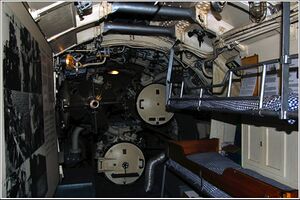
The success of the submarine is inextricably linked to the development of the torpedo, invented by Robert Whitehead in 1866. His invention is essentially the same now as it was 140 years ago. Only with self-propelled torpedoes could the submarine make the leap from novelty to a weapon of war. Until the perfection of the guided torpedo, multiple "straight-running" torpedoes were required to attack a target. With at most 20 to 25 torpedoes stored on board, the number of attacks was limited. To increase combat endurance most World War I submarines functioned as submersible gunboats, using their deck guns against unarmed targets, and diving to escape and engage enemy warships. The importance of guns encouraged the development of the unsuccessful Submarine Cruiser such as the French Surcouf and the Royal Navy's X1 and M-class submarines. With the arrival of anti-submarine warfare (ASW) aircraft, guns became more for defense than attack. A more practical method of increasing combat endurance was the external torpedo tube, loaded only in port.
The ability of submarines to approach enemy harbours covertly led to their use as minelayers. Minelaying submarines of World War I and World War II were specially built for that purpose. Modern submarine-laid mines, such as the British Mark 5 Stonefish and Mark 6 Sea Urchin, can be deployed from a submarine's torpedo tubes.
After World War II, both the US and the USSR experimented with submarine-launched cruise missiles such as the SSM-N-8 Regulus and P-5 Pyatyorka. Such missiles required the submarine to surface to fire its missiles. They were the forerunners of modern submarine-launched cruise missiles, which can be fired from the torpedo tubes of submerged submarines, for example, the US BGM-109 Tomahawk and Russian RPK-2 Viyuga and versions of surface-to-surface anti-ship missiles such as the Exocet and Harpoon, encapsulated for submarine launch. Ballistic missiles can also be fired from a submarine's torpedo tubes, for example, missiles such as the anti-submarine SUBROC. With internal volume as limited as ever and the desire to carry heavier warloads, the idea of the external launch tube was revived, usually for encapsulated missiles, with such tubes being placed between the internal pressure and outer streamlined hulls.
The strategic mission of the SSM-N-8 and the P-5 was taken up by submarine-launched ballistic missile beginning with the US Navy's Polaris missile, and subsequently the Poseidon and Trident missiles.
Germany is working on the torpedo tube-launched short-range IDAS missile, which can be used against ASW helicopters, as well as surface ships and coastal targets.
المجسات
A submarine can have a variety of sensors, depending on its missions. Modern military submarines rely almost entirely on a suite of passive and active sonars to locate targets. Active sonar relies on an audible "ping" to generate echoes to reveal objects around the submarine. Active systems are rarely used, as doing so reveals the sub's presence. Passive sonar is a set of sensitive hydrophones set into the hull or trailed in a towed array, normally trailing several hundred feet behind the sub. The towed array is the mainstay of NATO submarine detection systems, as it reduces the flow noise heard by operators. Hull mounted sonar is employed in addition to the towed array, as the towed array can't work in shallow depth and during maneuvering. In addition, sonar has a blind spot "through" the submarine, so a system on both the front and back works to eliminate that problem. As the towed array trails behind and below the submarine, it also allows the submarine to have a system both above and below the thermocline at the proper depth; sound passing through the thermocline is distorted resulting in a lower detection range.
Submarines also carry radar equipment to detect surface ships and aircraft. Submarine captains are more likely to use radar detection gear than active radar to detect targets, as radar can be detected far beyond its own return range, revealing the submarine. Periscopes are rarely used, except for position fixes and to verify a contact's identity.
Civilian submarines, such as the DSV Alvin or the Russian Mir submersibles, rely on small active sonar sets and viewing ports to navigate. The human eye cannot detect sunlight below about 300 أقدام (91 m) underwater, so high intensity lights are used to illuminate the viewing area.
الملاحة

Early submarines had few navigation aids, but modern subs have a variety of navigation systems. Modern military submarines use an inertial guidance system for navigation while submerged, but drift error unavoidably builds over time. To counter this, the crew occasionally uses the Global Positioning System to obtain an accurate position. The periscope—a retractable tube with a prism system that provides a view of the surface—is only used occasionally in modern submarines, since the visibility range is short. The Virginia، طراز and Astute، طراز submarines use photonics masts rather than hull-penetrating optical periscopes. These masts must still be deployed above the surface, and use electronic sensors for visible light, infrared, laser range-finding, and electromagnetic surveillance. One benefit to hoisting the mast above the surface is that while the mast is above the water the entire sub is still below the water and is much harder to detect visually or by radar.
الاتصالات
Military submarines use several systems to communicate with distant command centers or other ships. One is VLF (very low frequency) radio, which can reach a submarine either on the surface or submerged to a fairly shallow depth, usually less than 250 أقدام (76 m). ELF (extremely low frequency) can reach a submarine at greater depths, but has a very low bandwidth and is generally used to call a submerged sub to a shallower depth where VLF signals can reach. A submarine also has the option of floating a long, buoyant wire antenna to a shallower depth, allowing VLF transmissions by a deeply submerged boat.
By extending a radio mast, a submarine can also use a "burst transmission" technique. A burst transmission takes only a fraction of a second, minimizing a submarine's risk of detection.
To communicate with other submarines, a system known as Gertrude is used. Gertrude is basically a sonar telephone. Voice communication from one submarine is transmitted by low power speakers into the water, where it is detected by passive sonars on the receiving submarine. The range of this system is probably very short, and using it radiates sound into the water, which can be heard by the enemy.
Civilian submarines can use similar, albeit less powerful systems to communicate with support ships or other submersibles in the area.
Life support systems
With nuclear power or air-independent propulsion, submarines can remain submerged for months at a time. Conventional diesel submarines must periodically resurface or run on snorkel to recharge their batteries. Most modern military submarines generate breathing oxygen by electrolysis of fresh water (using a device called an "Electrolytic Oxygen Generator"). Emergency oxygen can be produced by burning sodium chlorate candles.[54] Atmosphere control equipment includes a Carbon dioxide scrubber, which uses a spray of monoethanolamine (MEA) absorbent to remove the gas from the air, after which the MEA is heated in a boiler to release the CO2 which is then pumped overboard. Emergency scrubbing can also be done with lithium hydroxide, which is consumable.[54] A machine that uses a catalyst to convert carbon monoxide into carbon dioxide (removed by the CO2 scrubber) and bonds hydrogen produced from the ship's storage battery with oxygen in the atmosphere to produce water, is also used.[بحاجة لمصدر] An atmosphere monitoring system samples the air from different areas of the ship for nitrogen, oxygen, hydrogen, R-12 and R-114 refrigerants, carbon dioxide, carbon monoxide, and other gases.[54] Poisonous gases are removed, and oxygen is replenished by use of an oxygen bank located in a main ballast tank.[بحاجة لمصدر][مطلوب توضيح] Some heavier submarines have two oxygen bleed stations (forward and aft). The oxygen in the air is sometimes kept a few percent less than atmospheric concentration to reduce fire risk.
Fresh water is produced by either an evaporator or a reverse osmosis unit. The primary use for fresh water is to provide feedwater for the reactor and steam propulsion plants. It is also available for showers, sinks, cooking and cleaning once propulsion plant needs have been met. Seawater is used to flush toilets, and the resulting "blackwater" is stored in a sanitary tank until it is blown overboard using pressurized air or pumped overboard by using a special sanitary pump. The blackwater-discharge system requires skill to operate, and isolation valves must be closed before discharge.[55] The German Type VIIC boat U-1206 was lost with casualties because of human error while using this system.[56] Water from showers and sinks is stored separately in "grey water" tanks and discharged overboard using drain pumps.
Trash on modern large submarines is usually disposed of using a tube called a Trash Disposal Unit (TDU), where it is compacted into a galvanized steel can. At the bottom of the TDU is a large ball valve. An ice plug is set on top of the ball valve to protect it, the cans atop the ice plug. The top breech door is shut, and the TDU is flooded and equalized with sea pressure, the ball valve is opened and the cans fall out assisted by scrap iron weights in the cans. The TDU is also flushed with seawater to ensure it is completely empty and the ball valve is clear before closing the valve.[بحاجة لمصدر]
الغواصات في الثقافة العامة
كتب غير خيالية
- Blind Man's Bluff: The Untold Story of American Submarine Espionage By Sherry Sontag, Christopher Drew,(with) Annette Lawrence Drew
مقالات عن الغواصات
- غواصة حربية
- Ballistic missile submarine
- الإتصال بالغواصات
- Wet sub
- غواصة تجارية
- Autonomous Underwater Vehicle
- Deep Submergence Vehicle
- Submarines in the United States Navy
- Submarine simulator, a computer game genre
- List of countries with submarines
- قائمة أعمال الغواصات
- قائمة متاحف الغواصات
- List of sunken nuclear submarines
- John Philip Holland
موضوعات متعلقة
- خط زمني لتكنولوجيا تحت الماء
- Modern Naval tactics
- بحرية نووية
- Submarine cable
- Submersible
- Semi-submersible
- Depth charge
- يو بوت
مقالات عن مركبات معينة
- Ships named Nautilus
- List of submarines of the Royal Navy
- List of submarines of the United States Navy
- List of Soviet submarines
- Submarines of the Chinese Navy
- Submarines of the French Navy
- List of submarines of the Indian Navy
- List of U-boats
مقالات عن فئات معينة من الغواصات
- قائمة فئات الغواصات
- List of submarine classes of the Royal Navy
- List of Soviet and Russian submarine classes
- List of United States submarine classes
براءات إختراع
- U.S. Patent 708٬553 - Submarine boat
المصادر
- ^ Sherman, Chris (14 April 2009). "Worlds Biggest Submarine". English Russia. Retrieved 21 May 2013.
- ^ الموسوعة المعرفية الشاملة
- ^ Submarine Heritage Centre - submarine history of Barrow-in-Furness
- ^ Mattias, L. (30 May 2011). "World's oldest submerged submarine reaches land". CNN. Archived from the original on 4 March 2016. Retrieved 29 January 2013.
- ^ Finlan, Alastair (2004). The Royal Navy in the Falklands Conflict and the Gulf War: Culture and Strategy. British Politics and Society. Vol. 15. London: Psychology Press. p. 214. ISBN 978-0-7146-5479-9.
- ^ "Sail Away - The Last Voyages of the Disneyland Submarines". Retrieved 24 April 2010.
- ^ "Mesoscaph "August Piccard"". Verkehrshaus der Schweiz. Archived from the original on 7 March 2016.
- ^ David Bruce Weaver (2001). The Encyclopedia of Ecotourism. CABI. p. 276. ISBN 978-0-85199-368-3.
- ^ Booth, William; Forero, Juan (6 June 2009). "Plying the Pacific, Subs Surface as Key Tool of Drug Cartels". The Washington Post.
- ^ "FARC's drug submarine seized in Colombia". BBC News. 5 September 2011.
- ^ أ ب ت ث ج ح خ د ذ ر ز س ش ص ض ط McLaren, Alfred S., CAPT USN "Under the Ice in Submarines" United States Naval Institute Proceedings July 1981, pp. 105–9
- ^ William J. Broad (18 March 2008). "Queenfish: A Cold War Tale". New York Times. Retrieved 17 February 2010.
- ^ "History of the USS Gurnard and Polar Operations".
- ^ "NavSource Online: Submarine Photo Archive". navsource.org. 14 November 2016. Retrieved 3 March 2017.
- ^ "HMS Superb (1976) (9th)". britainsnavy.co.uk. 12 January 2013. Retrieved 4 March 2017.
- ^ "Submarine Force Participates in Ice Exercise 2007". Government Press Releases (USA). 20 March 2007. Retrieved 1 February 2017.
- ^ "CNO Attends ICEX 2009". navy.mil. 24 March 2009. Archived from the original on 3 March 2017. Retrieved 3 March 2017.
- ^ "Physics Of Liquids & Gases". Elementary Classical Physics. Retrieved 7 October 2006.
- ^ Richard O'Kane (1987). Wahoo. Presidio Press. p. 12. ISBN 9780891413011.
- ^ Roy Burcher; Louis Rydill (1995). Concepts In Submarine Design. Cambridge University Press. p. 170.
- ^ Wang, Wenjin; et al. (2020). "A Fault-tolerant Steering Prototype for X-rudder Underwater Vehicles". Sensors. 20 (7): 1816. Bibcode:2020Senso..20.1816W. doi:10.3390/s20071816. PMC 7180876. PMID 32218145.
- ^ "Ohio-class Replacement Details". US Naval Institute. 1 November 2012. Retrieved 26 May 2020.
- ^ Granholm, Fredrik (2003). Från Hajen till Södermanland: Svenska ubåtar under 100 år. Marinlitteraturföreningen. p. 56. ISBN 9185944-40-8.
- ^ [1]. National Defense magazine. Archived 5 أبريل 2008 at the Wayback Machine
- ^ "Federation of American Scientists". Fas.org. Retrieved 18 April 2010.
- ^ "Trieste". History.navy.mil. Archived from the original on 17 March 2010. Retrieved 18 April 2010.
- ^ "US Naval Academy" (PDF).
- ^ "Details on German U-Boat Types". Sharkhunters International. Archived from the original on 24 February 2010. Retrieved 21 September 2008.
- ^ Miller, David; Jordan, John (1987). Modern Submarine Warfare. London: Salamander Books. p. 63. ISBN 0-86101-317-4.
- ^ Granholm, Fredrik (2003). Från Hajen till Södermanland: Svenska ubåtar under 100 år. Marinlitteraturföreningen. pp. 12–13. ISBN 9185944-40-8.
- ^ Granholm, Fredrik (2003). Från Hajen till Södermanland: Svenska ubåtar under 100 år. Marinlitteraturföreningen. pp. 12–15. ISBN 9185944-40-8.
- ^ Granholm, Fredrik (2003). Från Hajen till Södermanland: Svenska ubåtar under 100 år. Marinlitteraturföreningen. pp. 18–19, 24–25. ISBN 9185944-40-8.
- ^ Granholm, Fredrik (2003). Från Hajen till Södermanland: Svenska ubåtar under 100 år. Marinlitteraturföreningen. pp. 16–17, 20–21, 26–29, 34–35, 82. ISBN 9185944-40-8.
- ^ Granholm, Fredrik (2003). Från Hajen till Södermanland: Svenska ubåtar under 100 år. Marinlitteraturföreningen. pp. 40–43, 48–49, 52–61, 64–67, 70–71. ISBN 9185944-40-8.
- ^ أ ب Friedman, Norman (1995). U.S. submarines through 1945: an illustrated design history. Naval Institute Press. pp. 259–260. ISBN 978-1-55750-263-6.
- ^ Никoлaeв, A.C. "Проект "Пaлтyc" (NATO-"Kilo")". Энциклопедия отeчествeннoгo подводнoгo флотa. Retrieved 2 June 2020.
- ^ أ ب "What is motivations for ship electric propulsion". Electro-technical officer. Retrieved 2 June 2020.[dead link]
- ^ أ ب "Diesel–electric Propulsion Plants: A brief guideline how to engineer a diesel–electric propulsion system" (PDF). MAN Energy Solutions. pp. 3–4. Retrieved 2 June 2020.[dead link]
- ^ Ireland, Bernard (2003). Battle of the Atlantic. Barnsley, UK: Pen & Sword Books. p. 187. ISBN 978-1-84415-001-4.
- ^ Schull, Joseph (1961). The Far Distant Ships. Ottawa: Queen's Printer, Canada. p. 259.
- ^ Lamb, James B. (1987). On the triangle run. Toronto: Totem Books. pp. 25, 26. ISBN 978-0-00-217909-6.
- ^ Navy, United States (September 2008). The Submarine (in الإنجليزية). United States Printing Office. ISBN 978-1-935327-44-8.
- ^ "SS X-1". Historic Naval Ships Association. Archived from the original on 18 August 2013. Retrieved 24 February 2014.
- ^ "S-80: A Sub, for Spain, to Sail Out on the Main". Defense Industry Daily. 15 December 2008.
- ^ "Submarine Warfare". Archived from the original on 8 September 2006. Retrieved 7 October 2006.
- ^ "France Current Capabilities". Nti.org. Retrieved 18 April 2010.
- ^ Thompson, Roger (2007). Lessons Not Learned. US Naval Institute Press. p. 34. ISBN 978-1-59114-865-4.
- ^ Lee, T. W. (30 December 2008). Military Technologies of the World [2 volumes] (in الإنجليزية). ABC-CLIO. p. 344. ISBN 978-0-275-99536-2.
- ^ أ ب Johnston, Robert (23 September 2007). "Deadliest radiation accidents and other events causing radiation casualties". Database of Radiological Incidents and Related Events.
- ^ Strengthening the Safety of Radiation Sources Archived 26 مارس 2009 at the Wayback Machine p. 14
- ^ أ ب ت How Do Nuclear Submarines Make Oxygen?. www.youtube.com (video). Smarter Every Day 251. 21 February 2021. Retrieved 26 January 2022.
- ^ How to Poop on a Nuclear Submarine (256). www.youtube.com (video). Smarter Every Day. 9 May 2021. Retrieved 27 January 2022.
- ^ "U-1206". Uboat.net. Retrieved 18 April 2010.
- Gardiner, Robert (1992). Steam, Steel and Shellfire, The steam warship 1815-1905. Annapolis, Maryland: Naval Institute Press. ISBN 9781557507747. OCLC 30038068.
{{cite book}}: Cite has empty unknown parameters:|1=and|unused_data=(help) - Blair, Clay (1975). Silent Victory: The U.S. Submarine War Against Japan. Philadelphia: Lippincott. ISBN 9780397007530. OCLC 821363.
- Lockwood, Charles A. (1951). Sink 'Em All: Submarine Warfare in the Pacific. New York: Dutton. OCLC 1371626.
- O'Kane, Richard H. (1977). Clear the Bridge!: The War Patrols of the USS Tang. Chicago: Rand McNally. ISBN 9780528810589. OCLC 2965421.
- O'Kane, Richard H. (1987). Wahoo: The Patrols of America's Most Famous World War II Submarine. Novato, California: Presidio Press. ISBN 9780891413011. OCLC 15366413.
- Werner, Herbert A. (1999). Iron coffins: a personal account of the German U-Boat battles of World War II. London: Cassell Military. ISBN 9780304353309. OCLC 41466905.
وصلات خارجية
- Submariners Association - UK Submariners site and Boat Database
- Submarine #1 and The Fenian Ram - Photos John Holland's Submarine #1 and his second submarine, The Fenian Ram
- USS Nautilus Photos onboard the Nuclear Submarine USS Nautilus SS-571 in Groton, CT
- German Submarines of WWII and U-boat losses in 1943
- German Midget Submarines: Seehund and Molch
- Submarines of WWI
- Role of the Modern Submarine
- U.S. World War II Submarine Veterans History Project
- German submarines using peroxide
- Record breaking Japanese Submarines
- German U-Boats 1935–1945 (بالألمانية)
- U.S. submarine photo archive
- On Eternal Patrol memorial submarine site
- The Invention of the Submarine
- Submersibles and Technology by Graham Hawkes
- The Fleet Type Submarine Online US Navy submarine training manuals, 1944-1946. Formerly Restricted status.
- For Allied Tonnage Losses in 1943
- The Home Front: Manitowoc County in World War II: Video footage of submarine launches into Lake Michigan during WWII.
- The Sinking of the Ghazi
- DutchSubmarines : Including first ever submarine
- USS Lionfish Photos onboard the WWII Fleet Sub USS Lionfish in Fall River, MA
- Submarine Vesikko
- List of active Naval Submarines
- Articles with dead external links from February 2022
- Short description is different from Wikidata
- Articles with hatnote templates targeting a nonexistent page
- جميع الصفحات التي تحتاج تنظيف
- مقالات بالمعرفة تحتاج توضيح from January 2022
- مقالات ذات عبارات بحاجة لمصادر
- Articles with unsourced statements from October 2018
- Articles with unsourced statements from April 2020
- غواصات
- أنواع سفن
- قدور ضغط
